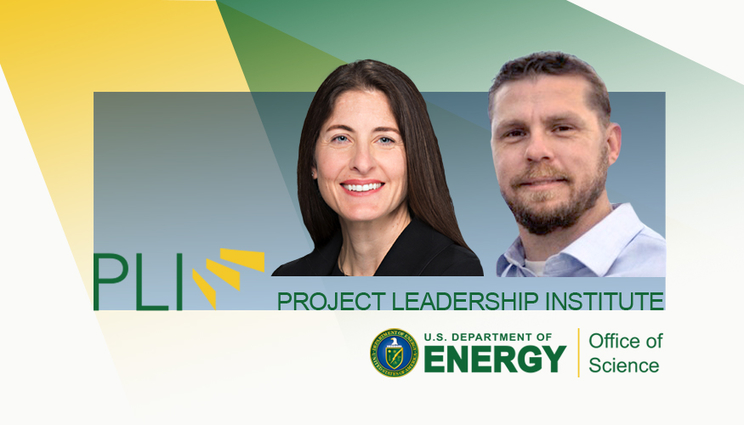Two LLNL scientists chosen for 2022 DOE Project Leadership Institute
 (Download Image)
(Download Image)
Lawrence Livermore National Laboratory’s Lara Leininger and Al Churby have been selected as Department of Energy (DOE) Project Leadership Institute (PLI) 2022 cohort participants.
The Department of Energy (DOE) Project Leadership Institute (PLI) has selected Lawrence Livermore National Laboratory’s Lara Leininger and Al Churby as 2022 cohort participants. Members of the PLI cohort have demonstrated their expertise as technical, business systems or project leaders, with significant experience and responsibility for project or organization performance and resources.
DOE has a long history of executing highly technical one-of-a-kind projects to accomplish its mission. The PLI program aims to cultivate a diverse network of successful DOE project delivery practitioners — those capable of delivering major high-risk projects.
Leininger currently serves as the director of LLNL’s Energetic Materials Center (EMC). Her responsibilities include oversight of ongoing scientific and engineering work as well as leadership of Laboratory efforts to define new facilities and capabilities to support energetic materials scientific questions and weapons program deliverables. Recently, she was principal investigator on a Laboratory Directed Research and Development Strategic Initiative, where she led a multi-institution team that developed experimental approaches and adapted high-energy-density experimental platforms to study high explosives in experimental campaigns across the DOE, including at the Laboratory for Laser Energetics Omega/EP facility at the University of Rochester, the Advanced Photon Source at Argonne National Laboratory, the Jupiter Laser Facility and the National Ignition Facility (NIF), both at LLNL. In 2020, she assumed the role of program manager for LLNL activities supporting the newly formed High Explosives & Energetics (HE&E) Program Office within DOE/NNSA’s Defense Programs. HE&E is responsible for producing high explosives and energetic materials that will be used for stockpile components and test articles.
“This is an exciting period of growth and relevance for the DOE’s national nuclear security enterprise — especially in explosives research,” Leininger said. “The next three to five years will include a strong beginning to firmly establish the HE&E portfolio of modernization projects for NNSA at LLNL using the project management principles and competencies demonstrated in the PLI, while working with our fantastic EMC team to continue to enable the program execution of the entire LLNL energetics enterprise. I’m so impressed by the diversity of talent in the cohort and look forward to getting to know everyone and learn more about common challenges and solutions that can be shared across the DOE complex.”
Churby currently serves as senior team lead/site project manager for the LLNL portion of the DOE/NNSA's major experimental effort, the Advanced Sources and Detectors (ASD) project. ASD is being constructed to generate high-speed, high-fidelity X-ray images of subcritical experiments to obtain technical information about the U.S. nuclear weapons stockpile. Churby has successfully led this team to achieve several critical milestones, including the completion of the ASD Scorpius program's annual review in August. He also has held several project leadership positions throughout LLNL's national security programs carried out for DOE/NNSA and Department of Defense customers.
“It’s an honor to be a part of this program and included in our cohort of current and future project leaders across the DOE and national laboratories,” Churby said. “My current ASD Project Director Dave Funk is a PLI alumnus and is someone I really admire as an effective project leader. As we move from the design phase to fabrication, installation and commissioning of the ASD radiographic system, the PLI modules — along with the capstone analysis of the DARHT [Dual Axis Radiographic Hydrodynamic Test] facility at Los Alamos National Laboratory — will be directly applicable to the remaining work associated with ASD’s planned commission in FY25/26.”
PLI’s learning objectives fall into four categories: strategic thinking/analysis, organization and general management skills, team building and communications. Through networking opportunities, informational sessions and independent work, the full PLI cohort will acquire the expertise critical to the successful leadership and execution of future organizational and DOE projects.
The first instructional session for Leininger, Churby and their cohort began in January. The instructional sessions are tailored to the DOE complex and incorporate content from Stanford University. Session topics range from positioning a project for success to leadership for strategic execution, with the final November session held in Washington, D.C. Themes include:
- Preparing to lead DOE projects
- Becoming a highly effective leader
- Positioning the project for success
- Leadership for strategic execution
- Delivering high-risk complex projects
- Navigating to the finish
Advancing project management practices and cultivating the next generation of leaders are crucial to building a culture of project management excellence across DOE. In 2014, then-Secretary of Energy Ernest Moniz called for the creation of the PLI, and the first cohort began in January 2017. LLNL has a history of participating in PLI; participants in the 2021 cohort included Gordon Brunton and Vincent Riot. For more details about the program and alumni, visit the PLI website.
— Stephanie Turza
Contact
 Michael Padilla
Michael Padilla
[email protected]
(925) 341-8692
Related Links
Project Leadership InstituteTags
Advanced Materials and ManufacturingMaterials Science
People
Physical and Life Sciences
Defense
Careers
Featured Articles







